One of Cebu's tourist attractions is the Archdiocesan Museum.
It is located in P. Burgos Street, Cebu City.

What's up Hive! How are you today? I hope everybody is doing well.
Cebu is one of many islands in the Philippines that is colonized by foreign countries.
Our language, culture, religion, belief, education, arts, and architecture are influenced by these countries.

There is signage beside the huge front door of the museum.
The entrance fee of the museum is only 10 pesos, or 0.17 US dollars.
It is open to the tourists from 9 o'clock in the morning until noon.
In the afternoon, they are open from 1 o'clock to 5 o'clock.

Near the front door of the museum, there you can see an antique wood bench with a unique Spanish design.

On the lobby near the front desk, there is a giant aged chandelier made up of shells hanging on the solid walnut wood ceiling.
Inside, you can see a lot of artifacts, relics, remains, antiques, old paintings and photographs, sculptures, books and some of the stories about the past.

The vintage floor, the historic wall, and the beautiful and perfect arc shape of the door going to the museum's garden.
The architectural design of the museum is more in the Spanish Era. It was also built during that period.
I was impressed by the Spanish-style exterior of the infrastructure.
I really thought that it was an ancestral house that was preserved by the children and grandchildren of the original owner of the property.
I sneaked and I found out that it is a museum and one of the tourist attractions here in Cebu.
There are also a lot of tourists visiting the place. They are enjoying the displays and the interior of the museum.

The hallway that goes to the second floor of the museum.

The staircase that goes to the second floor of the museum.
I was impressed with the design of the baluster. It was perfectly made. It is made up of solid wood. The workmanship is amazing.
The people who planned and built during that time were truly gifted with skills and talent because, way back then, they did it without using a machine.

The stairway goes to the basement.
On the column beside the stairs that goes to the basement, there is a sign about the history of the museum.
It was written there that the multi-layered floor elevation of the museum signifies different uses of the structure in the different eras, exposing the different floors of the old "Zaguan" or "Ground Floor" of the Cathedral Convent.
The lowest floor, made of earth, dates back to the Pre-construction Period.
The upper layer, thereafter, expose the different types of flooring reflect different time periods.
Spanish - Coral stone blocks
American - Concrete
Post-War - Concrete with red dye or Muralo and concrete polish aggregates.




European stoneware and kitchenware sherds, ca. 1850s - 1900s

Bones of cows and wild well as domesticated pigs that formed part of the diet of the priests.



Blue and white Chinese trade ware ceramic sheds, mostly probably of the Ching Dynasty period (1644-1910). The sherds appear to be mid-1700s to late 1800s.


Fragments of wine bottles dating to the late Spanish period, ca. 1850s

American colonial period ceramics, mostly of European origin.
Now, let us take a tour to the second floor of the museum.

Sacra
It is a set of prayers used in the Tridentine or Latin Mass.

Cajuela
It is a container for chalice. The wood height is 13.2 cm.

An antique Choir book
A large book containing the chants and music.



Vintage bench made of solid wood.

Vintage wood cabinet


Vintage Wood chairs

Vintage huge box
In our language, we call it "Kaban" in Bisaya and "Baul" in Tagalog. In English, it is called a "Trunk" or "Clothes chest"

Antique wood chair


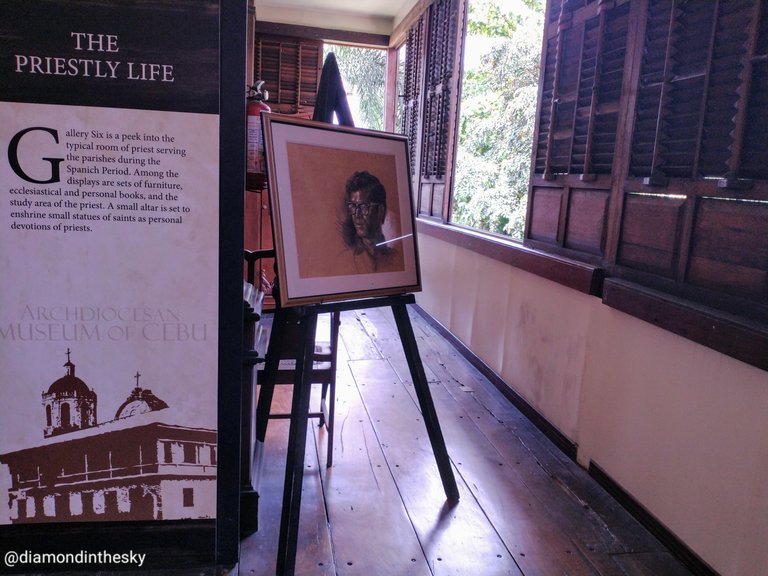


The craftsmanship of this giant wood chair is impressive.

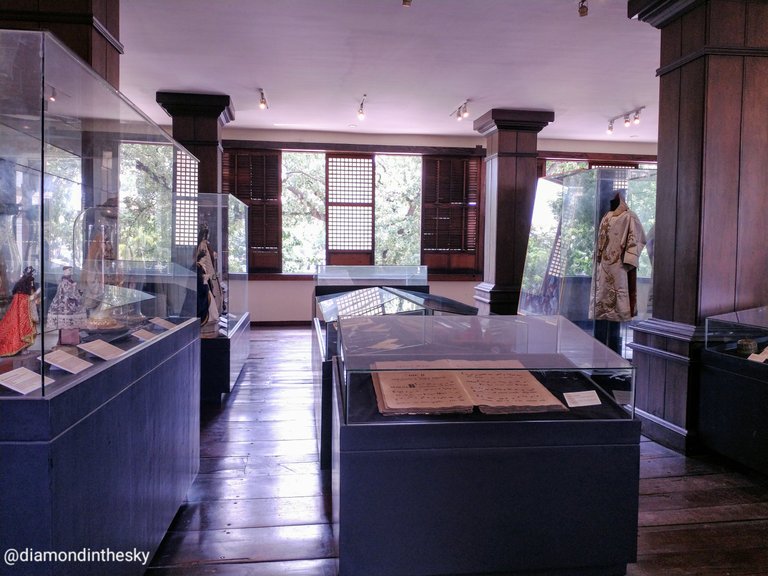
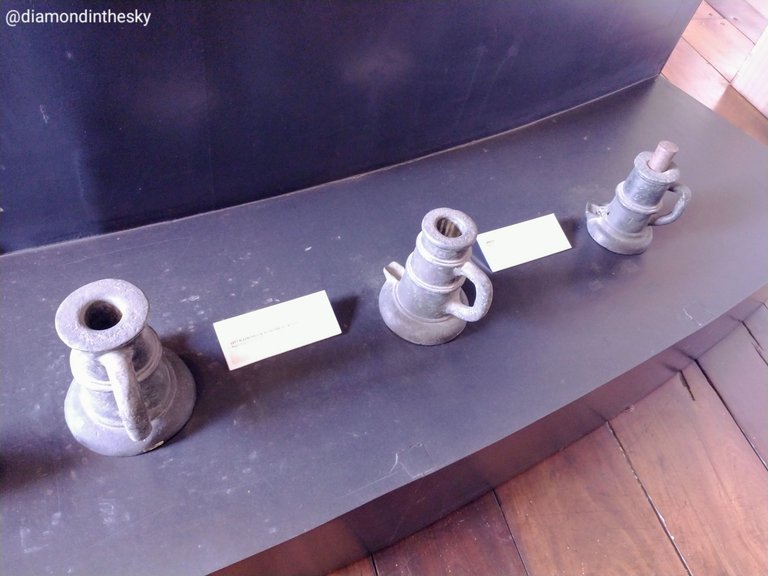

Falconete
It is a bronze swivel cannon with the length of 61.5 cm.

Hostiario
It is made of cast iron with the length of 97 cm.

Water Filter
It is made up of carved limestone.

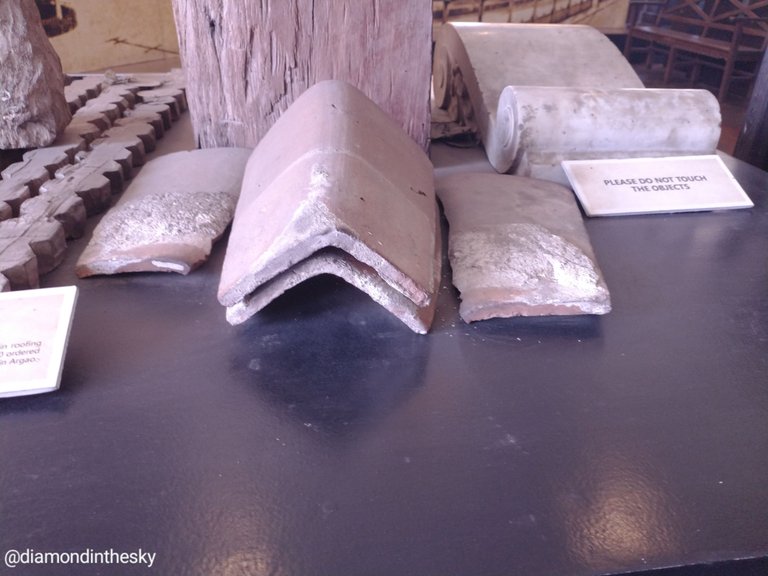

Part of a waterlogged haligi (Post)

Tejas of roof tiles
Mid-1800s
It is a high-fired and angled clay tiles called Tejas ruled the day in roofing houses and other infrastructures.

Tabique Pampango
Bamboo and Plaster
c. 1850
It was written there that it was made by knitting pieces of lumber or bamboo together. In the empty spaces between interwoven nodes, pieces of wood were inserted to support the partition. These were then plastered over using mortar-made lime, sand, and water, perhaps even egg whites and milk.

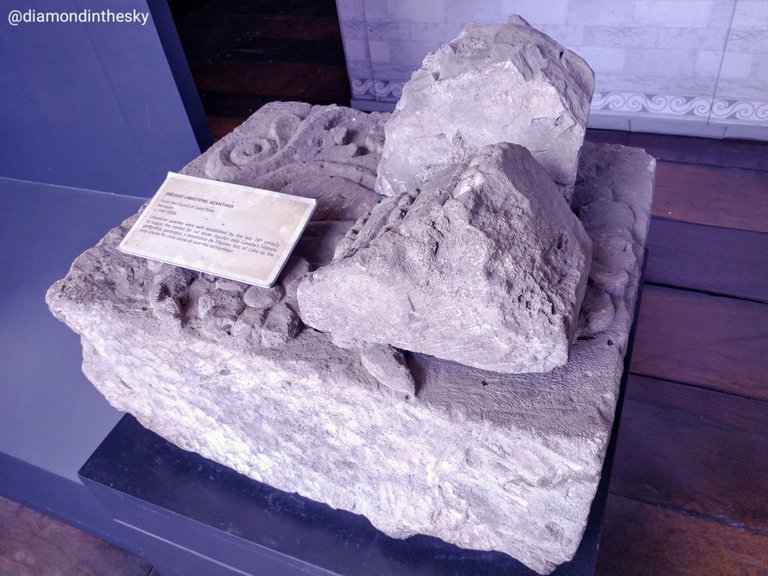
Dressed Limestone, Acanthus
c. mid-1800s
It was written on the label that the limestone quarries were well established by the late 18th century to supply the market for cut stone. Agustin dela Cavada's Historia geografica, geologica y estadistica de Filipinas lists Cebu as the only source for coral stone all over the archipelago.



That concludes my tour to Cebu's Archdiocesan Museum. I appreciate you taking the time to read my blog. Take care and have a safe travel.😊
//:# (//:# (!worldmappin 10.29614 lat 123.90356 long d3scr))
Ho Ho Ho! @diamondinthesky, one of your Hive friends wishes you a Merry Christmas and asked us to give you a new badge!
The HiveBuzz team wish you a Merry Christmas!
May you have good health, abundance and everlasting joy in your life.
To find out who wanted you to receive this special gift, click here!
You can view your badges on your board and compare yourself to others in the Ranking
Check out our last posts:
Wow! Thank you so much @hivebuzz for delivering the Christmas badge. Merry Christmas ☺️🎇🎇
Merry Christmas to you and your family. Thank you so much for everything... your help, recognition, and support. Thank you for counting me in. Thank you for letting me feel that I belong. I am so grateful ☺️❤️Likewise, @hivebuzz ☺️
You can check out this post and your own profile on the map. Be part of the Worldmappin Community and join our Discord Channel to get in touch with other travelers, ask questions or just be updated on our latest features.
Thank you so much @worldmappin for the support. I couldn't have done anything without you. My heart is grateful.😊
Hey I love vintage! Might visit this soon!❤️❤️
The place is perfect for tourists who love antiques and vintage. You will love and enjoy it for sure @shannjevie 😊
This museum makes me appreciate everything, no matter how random they may be, because when the time comes, it's going to be so valuable just like everything there
The collections may be old, but they are very valuable. It is a treasure that tells us about the past. 😊Exactly, @xavierariz
Very cool museum and it shows all the cultures that have been in PH
The museum showcases the history, arts, and culture of my country.You're definitely right, @coolmidwestguy 😊
I really like museums 🤩
I wish you could visit @marieyanlab during your free time. You will surely enjoy the remnants, artifacts, and all the collections displayed in that museum. 😊
I'm more amazed with ceramic sherds.
Imagine 100 years from now, if you broke your vase and people from the future put it in the museum haha
There's a possibility that even our photos may be put in the museum 50 or 100 years from now. 😊Hahaha you're right @anonymous02
The tour of Cebu's Archdiocesan Museum is fascinating! The historical artifacts and religious treasures highlighted in the article offer a rich glimpse into the region's culture and spiritual heritage.
I enjoyed taking down notes and at the same time, I am overwhelmed by how they value the things from the past, just like the 1800s-1900s broken glasses of wine. 😊I had a great time during my tour at that museum @milesinverse
This is such an interesting tour Ma'am @diamondinthesky. The vintage pieces and history shared in the museum are amazing. Thank you for sharing this, I’d love to visit it next time I'm there 🥺💗
I am truly amazed of the architecture and vintage collections in that place. 😊I wish you could visit the museum @fevyulous 😊
Travel Digest #2403.
Become part of our travel community:
- Join our Discord
Hiya, @ybanezkim26 here, just swinging by to let you know that this post made it into our Honorable Mentions in Your post has been manually curated by the @worldmappin team. If you like what we're doing, please drop by to check out all the rest of today's great posts and consider supporting other authors like yourself and us so we can keep the project going!Thank you so much Sir @ybanezkim26 and @worldmappin for the support. I am very grateful and with so much joy. 😊
Keep up the great work 💪
I didn’t realize how much history is preserved in the Archdiocesan Museum. 💓
I wish you could visit the place @itsmemic during your free time. You will truly enjoy the vintage collections. The museum showcases the events, arts, architecture,and culture. 😊
Wow! I got mesmerized by the amount of history that this museum holds. Thank you so much for showing us around. Honestly, I've never been to any museums. Oh, how I love to visit one someday.